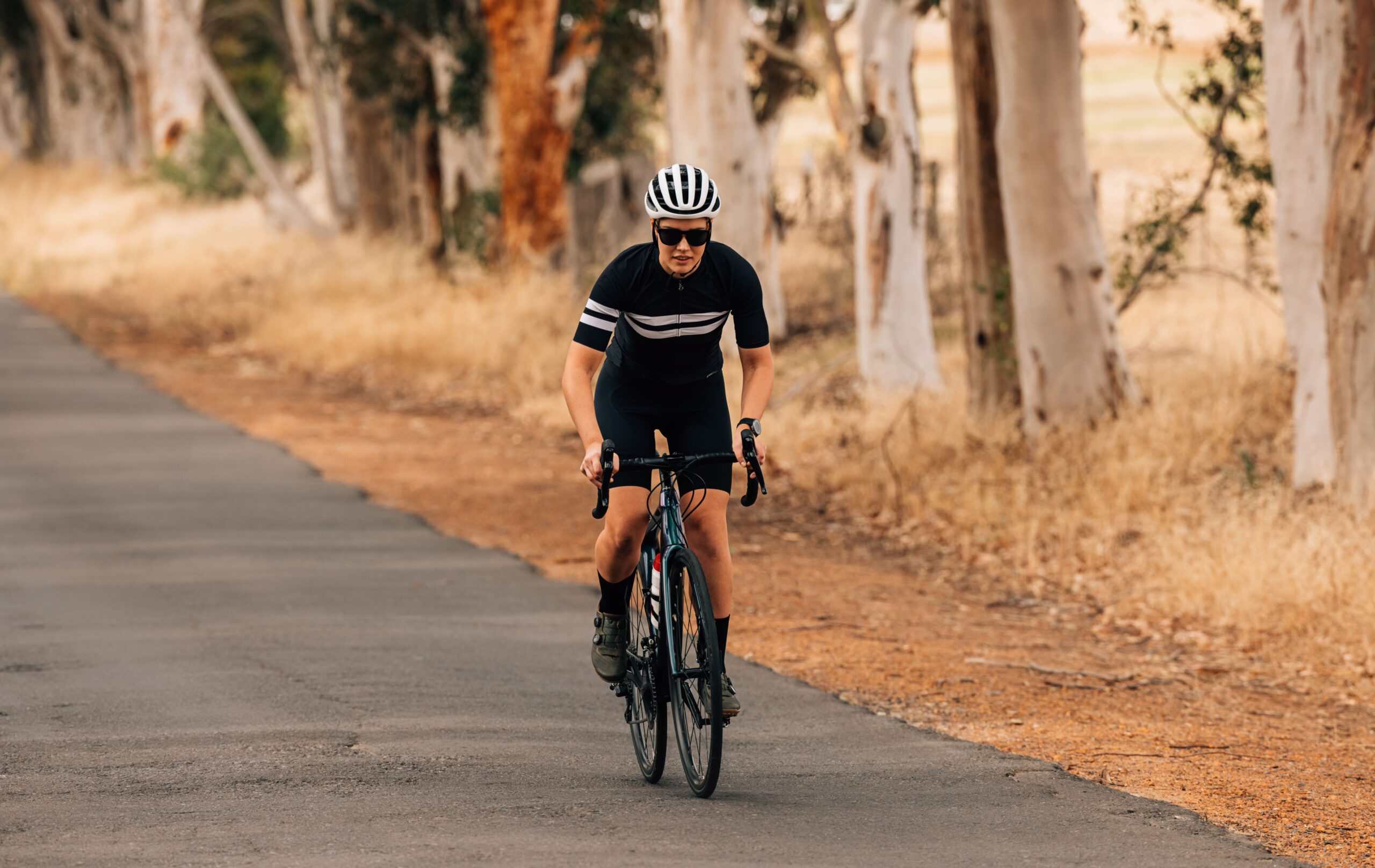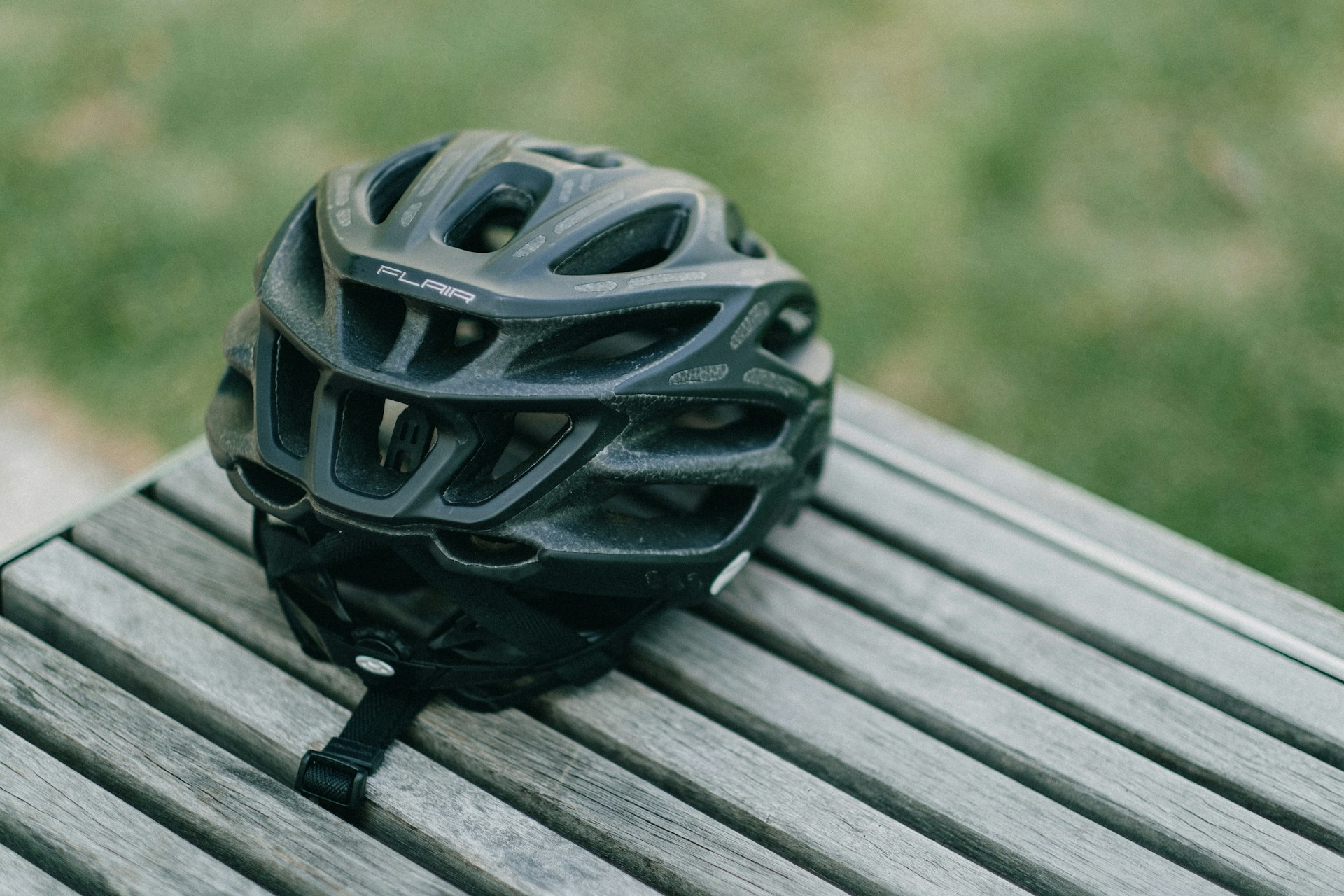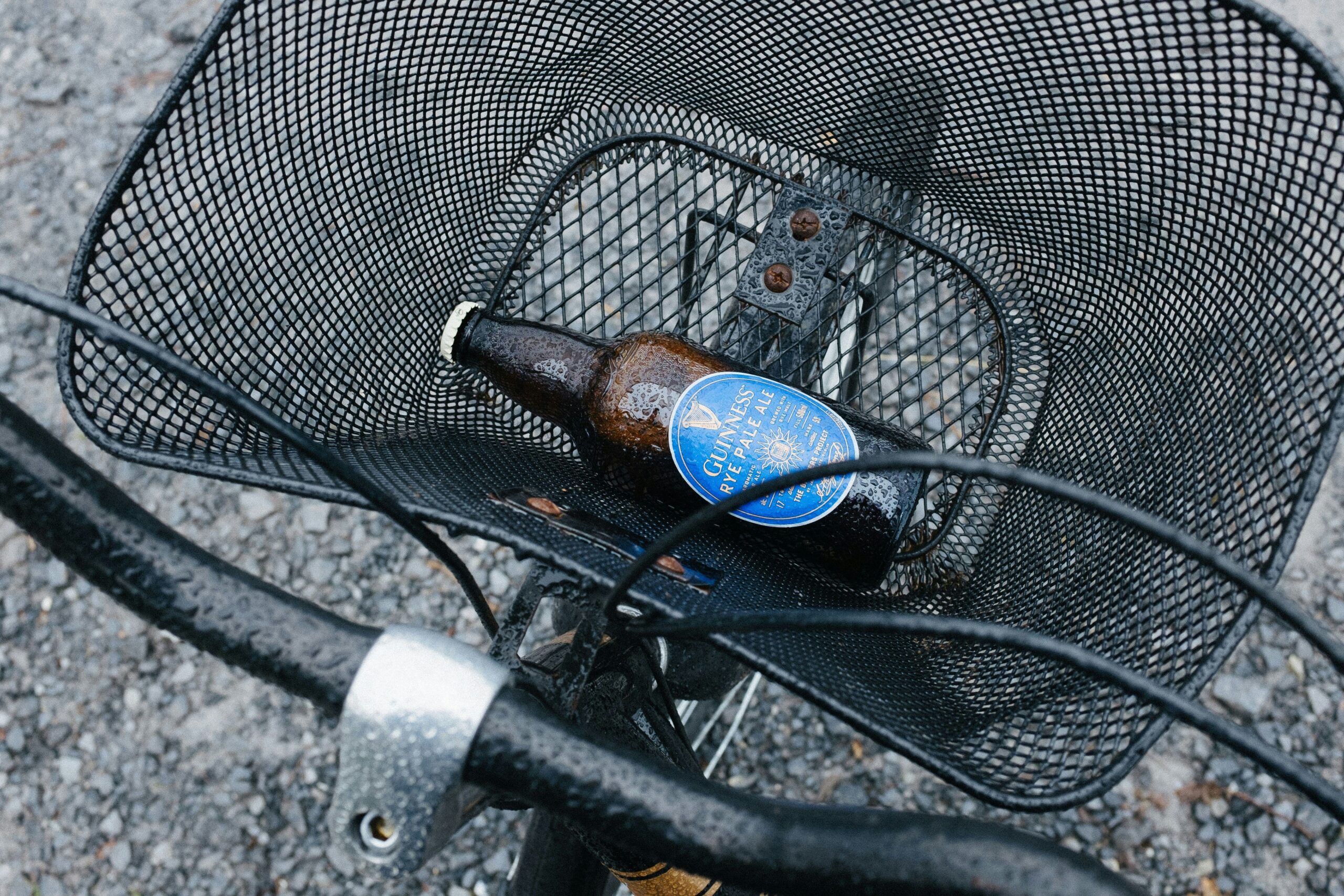Florida bicycle laws define bikes as human-powered vehicles and riders as rightful participants in traffic. All cyclists in the state have to abide by the same rules and regulations as motor vehicle operators. Not only do riders have to follow traffic signals and signs, but they also bike in the same direction as the rest of the vehicles, use hand signals, provide bicycles with necessary equipment, and ensure proper passenger safety. These laws aim to both protect vulnerable road users, such as cyclists, and hold negligent parties accountable in the event of an accident.
What Traffic Laws Apply to Cyclists in Florida?
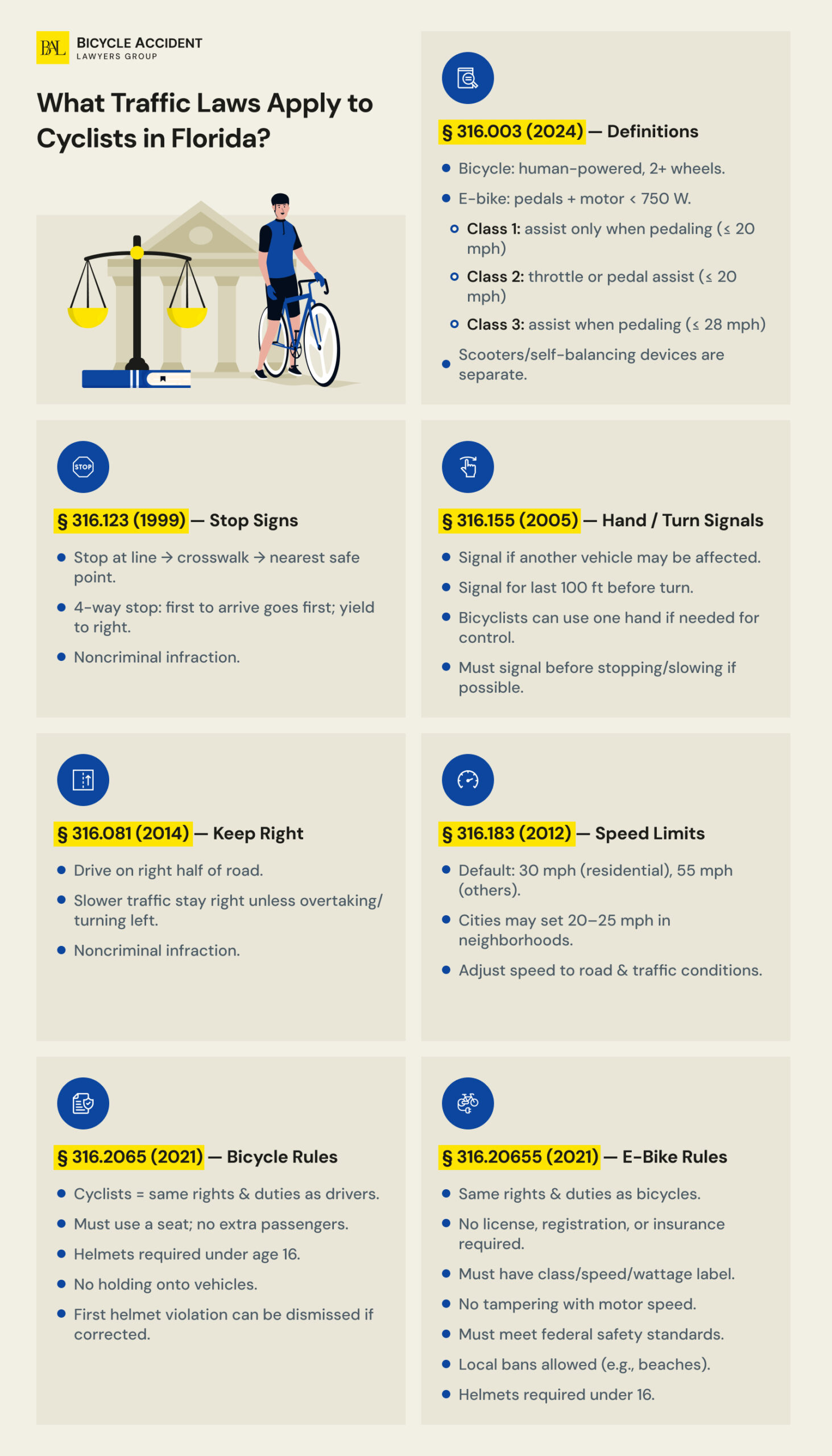
Florida Statutes outline a list of key rules that apply specifically to bicycle riders. The most relevant laws include, but aren’t limited to, the following:
- Fla. Stat. § 316.003 (2024): The official definition of bicycles and ebikes
- Fla. Stat. § 316.123 (1999): Stopping at intersections and stop signs
- Fla. Stat. § 316.155 (2005): When a hand signal is required
- Fla. Stat. § 316.081 (2014): Driving on the right side of the road
- Fla. Stat. § 316.183 (2012): Speed restrictions
- Fla. Stat. § 316.2065 (2021): State-approved bicycle regulations
- Fla. Stat. § 316.20655 (2021): Electric bike regulations
Relevant traffic laws aren’t the only thing a rider should be familiar with while cycling in Florida, there are a fair share of rights that the state law grants bicyclists. Let’s explore them together.
What Rights Does the Florida Law Grant Cyclists?
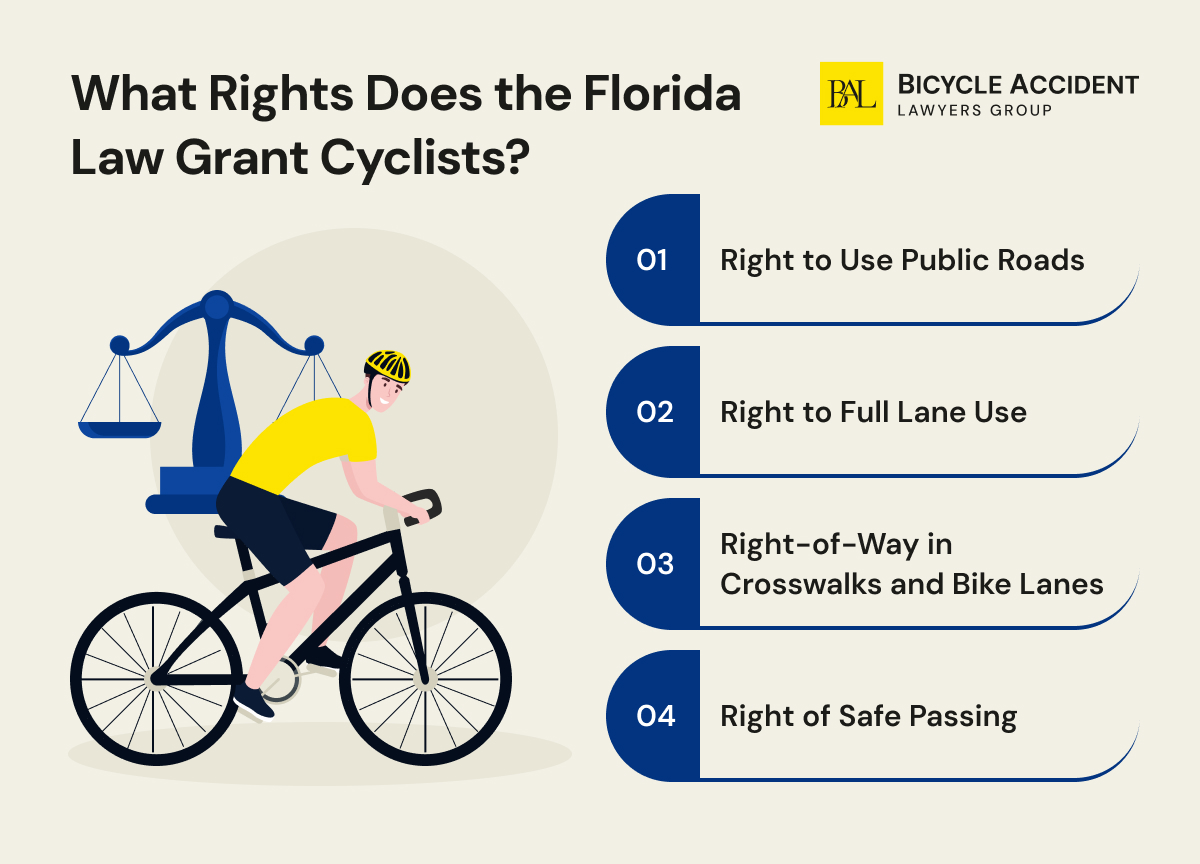
Bicycle riders in the Sunshine State are considered drivers (Fla. Stat. § 316.2065(1)). They can use public roads and shared lanes. Bicyclists may also use sidewalks, but they must yield to pedestrians (Fla. Stat. § 316.2065(10)). Yet, cyclists must obey traffic signs and use hand signals (Fla. Stat. §§ 316.155, 316.157) to travel safely.
Helmet Laws
Q: Are helmets mandatory in Florida?
A: Starting from 1997 bicycle riders under 16 are required to wear a protective helmet while cycling in the state (Fla. Stat. § 316.2065(3(d)). Adults are advised to wear helmets, but aren’t required to.
Right to Use Public Roads
Bicyclists can navigate local streets and public roads freely. Moreover, state law forbids motor-vehicle drivers from forcing cyclists off the road. However, riders are banned from limited-access roadways (Fla. Stat. § 316.091(2)), primarily because of heavy traffic loads and high speed limits that apply to these areas.
Right to Full Lane Use
The state-approved statutes require bicyclists to ride as close to the right side of the road as practicable. However, some exceptions enable cyclists to use the full lane legally. These exceptions are outlined in the section (Fla. Stat. § 316.2065(5)(a)) and primarily concern lanes that are too narrow and those that contain all sorts of hazards and obstacles.
On top of that, the Sunshine State has adopted the 3-foot passing rule (Fla. Stat. § 316.083(2)–(3)), which requires drivers to maintain a safe distance while overtaking bicyclists and ebike riders.
Right-of-Way in Crosswalks and Bike Lanes
Although bicycles are vehicles under Florida law, cyclists are treated as pedestrians only on sidewalks and in crosswalks (not in bike lanes). In those situations, drivers must yield to the cyclist, and the cyclist must yield to pedestrians and give an audible signal when passing (Fla. Stat. §§ 316.2065(9)–(10), 316.130(7); § 316.003(5)).
Right of Safe Passing
Bicyclists often face increased danger when they ride in shared or unprotected lanes. In 2024, over 200 riders sustained fatal injuries in crashes across Florida. When a cyclist gets crowded or is pushed onto a curb by a driver, it can lead to serious injuries. That is why state law mandates that drivers give riders enough room. The 3-foot passing rule (passed in 2006) requires that a motorist initiate the corresponding maneuver only when there’s enough room to complete it without threatening other road users. Failing to comply with the law may lead to fines and penalties, not to mention liability claims in case of an accident.
Cyclists and Motorists in Florida Share the Same Rights
The state law of Florida grants bicycle riders a solid legal footing, the same as any driver would have in case of an accident. Whether a motorist causes a crash or disputes liability, the injured cyclist can negotiate a fair settlement based on timely reporting and solid evidence of the sustained losses. However, victims often face blame-shifting and lowballing. To avoid that and recover fair compensation, it is always a good idea to get legal help from a trusted source. If you’ve been involved in a cycling incident — contact our lawyers for a free consultation today!
What Are the Main Responsibilities of Bicyclists Under Florida Law?
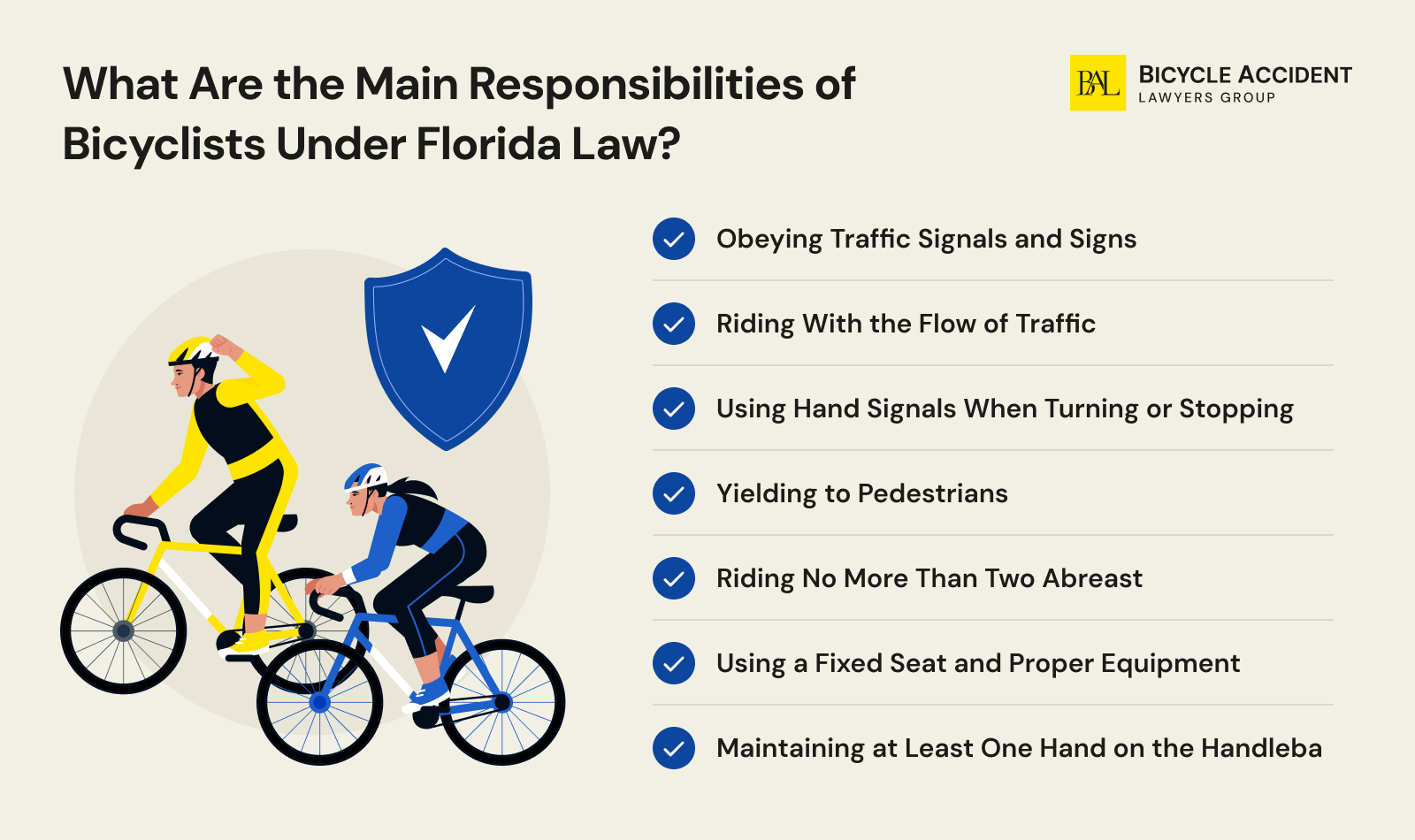
All bicycle riders across the state carry a fair share of responsibilities. Here’s a list of duties that every cyclist in the state must comply with. They include, but aren’t limited to, following traffic lights, giving the right of way to pedestrians, and meeting safety equipment requirements.
1. Obeying Traffic Signals and Signs
The law sees bicycles as legal vehicles, which means that all riders are obliged to come to a complete halt at red lights and stop signs. Just like the rest of the motorists, cyclists must also follow all posted traffic signals (§ 316.075) and control devices (§ 316.074).
2. Riding With the Flow of Traffic
Bike riders aren’t allowed to move against the traffic but follow in the same direction. This is a logical precaution to make yourself visible to the rest of the road users and decrease the risk of a traumatic collision. Besides, bicyclists who violate the law may be warned or even cited when caught.
3. Using Hand Signals When Turning or Stopping
Since bicycles aren’t equipped with corresponding turn and stop signals, riders have to use their hands to communicate with other motorists (Fla. Stat. § 316.157(2)).
- Left turn: Extend the left arm out.
- Right turn: Extend the right arm out, or extend the left arm upward.
- Stop: Extend the left arm downward.
4. Yielding to Pedestrians
In every instance where cyclists and pedestrians share the lane, the latter come first. Thus, when approaching a walker, a rider has to slow down, offer the pedestrian enough space to pass, and notify others using their voice or a bell when necessary (§ 316.2065(10)).
5. Riding No More Than Two Abreast
Bicyclists in Florida are allowed to ride side by side. However, if such riding interferes with the flow of the rest of the traffic, cyclists should switch to a single file. The move will ensure that other motorists can pass them safely and respect everybody’s right to the road (§ 316.2065(6)).
6. Using a Fixed Seat and Proper Equipment
Florida Statutes mandate that cyclists ride only on a vehicle that is fully functional and well-equipped. Such a bike must have a fixed seat, operational brakes, and working front and rear lights. Passengers are allowed as long as the bicycle is designed for such transportation (§ 316.2065(2), (7), (8)).
7. Maintaining at Least One Hand on the Handlebars
Maintaining at Least One Hand on the Handlebars — Florida does not have a current statewide “one-hand” requirement; riders can be cited if carrying objects that prevent safe control. Focus on control and safe operation, not a “one-hand” mandate.
Over 950 bicyclists suffered serious injuries after collisions recorded in Florida in 2024. One of the major factors in these accidents was failure to yield. On top of that, cyclists across the state sometimes ride against the traffic and neglect equipping their vehicle with proper gear, which compromises their safety and leads to frequent collisions. Thus, by fulfilling the aforementioned duties, bicyclists can not only protect themselves, but also ensure a safer environment for other road users.
Where Are Bicyclists Legally Allowed to Ride Bikes in Florida?
Bicyclists are allowed almost anywhere in the state, except for the limited-access highways. You can ride on public roads, bike lanes, and sidewalks in Florida, unless specific local regulations prohibit it.
| Type of road | Allowed/Forbidden | Legal background |
| Public roads | Allowed | Bicyclists share the same rights as motorists in Florida (§ 316.2065(1)) |
| Bike lanes | Allowed | These areas are dedicated to cycling solely |
| Shared lanes | Allowed | Bicyclists can use shared lanes if there are no bike paths in the vicinity, but keeping to the far right side is a must. (§ 316.2065(5)(a)) |
| Sidewalks | Allowed | Riders are generally permitted to use sidewalks in Florida, but local restrictions may be in place.(§ 316.2065(10)) |
| Limited-access highways/interstates | Forbidden | Cyclists are specifically forbidden to ride upon a limited-access highway. (§ 316.091) |
It is important to note that local municipalities may override existing state laws. So, in Jacksonville Beach, bicyclists aren’t allowed on sidewalks, while in Tampa, cyclists can’t use sidewalks in business districts.
What Traffic Laws Apply to Cyclists in Florida?
All the main traffic laws apply to bicyclists in the Sunshine State. They are designed not only to keep cyclists and other road users safe, but also to avoid citations and liability should an accident occur.
The major responsibilities that concern pedalcyclists in Florida are the following:
- Follow the signals and lights: Riders must not run a red light or ignore a stop sign.
- Move with the traffic: Bicyclists aren’t allowed to ride against the traffic.
- Signal sudden stops and turns: Cyclists should use universal hand signals to alert the rest of the road users about their movements.
- Ride two abreast: Side-by-side riding is permitted (maximum two abreast). If traveling below normal traffic speed and impeding traffic, riders must ride within a single lane or single file as needed.
- Use a full lane before turning: If you are about to make a left turn, you may use the full lane to complete the maneuver safely.
- Abide by seat and rider requirements: It is forbidden to use a vehicle without a fixed seat in the state. Also, you can’t transport passengers on a bike that isn’t made or equipped for the purpose.
Additionally:
Additionally: Bike riders may be cited for wearing headsets/headphones that cover both ears (§ 316.304, with one-ear exceptions) or for riding under the influence (§ 316.193).
Required Bike Equipment and Safety Gear in Florida
Bicyclists in Florida must equip their bikes with front and rear lights, reflectors, and brakes. Helmets are mandatory only for riders/passengers under 16 (all bicycle types). Many safety-conscious cyclists choose to wear reflective clothing to boost their visibility on the road. Reflective items are especially helpful during darker hours of the day. It is possible to attach mirrors and bells to a bike for better awareness while on a ride. It’s also common to add mirrors or bells, though they’re not required by law.
Helmet Laws in Florida
Protective headgear is required for minors under 16. Adults often choose helmets because they can reduce injury severity and may strengthen a future insurance claim. In fact, almost 40% of cyclist deaths that involve a traumatic brain injury happened because the rider didn’t have a helmet on or wore it improperly.
What Is Prohibited When Cycling in Florida?
There are five major restrictions when it comes to biking across the state. They are the following:
- A rider isn’t allowed to attach themselves to other moving vehicles.
- You can’t carry children under four years of age anywhere else but in a special seat or sling.
- It is forbidden to leave minors unattended on a bicycle.
- Florida law is exceptionally strict about wearing headphones. Cyclists can’t wear devices that obstruct incoming sound in both ears. One-ear use is permitted for specific devices (e.g., in conjunction with a cell phone) so the other ear remains open to traffic sounds (§ 316.304(2)(d)).
- Cyclists should maintain a 3- to 4-foot distance while passing parked vehicles. Unlike some states, the Sunshine State has a dooring law in effect (§ 316.2005). According to this regulation, it is forbidden for vehicle operators to open car doors or leave them open so that they interfere with the rest of the traffic.
Can You Get a DUI on a Bike in Florida?
The DUI law for bike riders mirrors that of motorists. It is illegal to drive under the influence in Florida. Alcohol and drug regulations may differ from county to county and imply different penalties. Generally, it is possible to receive a verbal warning, a fine, an arrest, or even a license suspension, if a rider has a valid driver’s license.
Not so long ago, a rider was arrested and released on 1 $1.5K bond for driving under the influence in Sanibel Island. The case proves that local authorities are serious about DUI violations applicable to bicyclists.
Local City-Specific Bike Laws in Florida
Florida Statutes are statewide regulations recognized by all regions. However, local biking ordinances can overrule those because of specific circumstances in the area. Thus, municipal codes are sometimes the ones that regulate riding on sidewalks, wearing helmets, hosting safety campaigns, and designating bike paths. That is why, in some cities, riders are banned from busy sidewalks, while in others, bicyclists are mandated to use additional lighting or reflective gear in certain zones or parts of the city. Let’s take a closer look at how major cities in Florida treat state-approved laws.
Miami Bike Laws
The city of Miami recognizes state laws, but has a fair share of local rules in place. For instance, in downtown Miami and other densely populated areas of the city, cyclists aren’t allowed on sidewalks. These regulations are designed to enhance pedestrian safety. However, in the Miami-Dade region, bicyclists under 10 years old are permitted to use sidewalks. As local cycling infrastructure expands, new ordinances may appear, so it is always a wise move to consult an up-to-date city code before going for a ride.
Orlando Bike Laws
In Orlando, cyclists must abide by the statewide biking laws. This implies following traffic rules, riding with the flow of traffic, using proper equipment, and wearing helmets (for minors under 16 years). At the same time, the city government puts a lot of effort into improving the local bicycling network. Orlando enlists over 265 miles of on-street bike lanes and 45 miles of off-street and multi-use paths. More improvements, such as bike boxes and protected intersections, are on the way.
Tampa Bike Laws
The city of Tampa, as well as the rest of Hillsborough County, follows Florida bicycle rules but introduces its own initiatives to make the area more cyclist-friendly. For instance, local authorities continue to improve, expand, and innovate various biking facilities, which include, but aren’t limited to, green boxes at intersections, marked lanes, linking plans, and free helmet distribution, especially for children.
Sarasota Bike Laws
Sarasota is another city that respects existing state statutes. All riders in the area are bound to obey traffic signals and signs, communicate turns, avoid wearing headphones, and equip their vehicle with the required lights and reflectors. However, there’s also a local Sarasota master plan which aims to improve cycling infrastructure, enhance rider safety, and promote helmet use among all categories of bicyclists. The Sarasota Police Department has also suggested a voluntary bike registration program to prevent theft and encourage timely accident reports.
Jacksonville Bike Laws
Bicyclists in Jacksonville have to abide by the state law, except for sidewalk riding regulations. Riders can’t use sidewalks inside business districts in the city. Although outside these areas, cycling on sidewalks isn’t illegal, it is discouraged. Mainly because the area prides itself on a more than extensive and versatile biking trail system — there are around 900 miles of bicycle lanes and paths in the city. On top of that, various local initiatives like Share the Road help to reinforce cyclists’ rights and boost motorist awareness.
Florida Electric Bike Laws
Florida’s classification system of ebikes aligns with national standards. According to Florida law, electric bicycles are divided into three classes (Fla. Stat. § 316.003(23)). Each class has its own speed-related and operational specifications. Generally, e-bikes are treated as traditional bikes in Florida, so riders follow the same rules. Helmet use is required for riders/passengers under 16 (all bicycle types); there is no statewide Class 3-only helmet mandate for adults.
E-bicyclists do not need special licenses or permits to operate such a vehicle. The same applies to registration or insurance — neither is mandatory. However, local municipalities may have specific requirements or restrictions in place, so it is a good idea to browse through local bicycle codes to ensure that you do not break any local laws while e-biking in the area.
Do I Need a Driver’s License to Ride a Bike in Florida?
Bicyclists are viewed as legal drivers in the state, but the riders do not need a valid driver’s license to operate a bike, even an electric one. Bicycles are classified as human-powered vehicles, and only motor vehicles require a license (§ 316.003(4)). However, in states like Alabama, Alaska, Massachusetts, Missouri, New Mexico and North Dakota ebike riders need a license to operate the vehicle legally.
Car Driver Responsibilities Related to Cyclists
Motor vehicle operators have a fair share of duties to fulfill when it comes to sharing the road with other vulnerable road users, such as bicyclists in Florida. On top of all the rational safety precautions, drivers are bound to grant cyclists the right of way. Moreover, the motorist has to preserve a safe passing distance when taking over a rider. They also have to check for pedalcyclists when turning or opening car doors. These responsibilities aren’t mere formalities; they are aimed at protecting both drivers and riders from serious collisions.
Most Common Injuries of Cyclists
Cycling is a healthy and generally safe activity that grows in popularity as we speak. For instance, in post-Covid years, rates of bicycle commuting in Miami grew by over 200%. However, the lack of cyclist protection, speed of the surrounding traffic, and other contributing factors often result in serious injuries, such as:
- Head trauma: A bike accident can lead to serious traumatic brain injuries, even if the rider wears a helmet.
- Back injuries: Various types of spinal cord damage can have a lasting, if not permanent, effect on the life of the injured.
- Fractures: Broken bones, such as arms, wrists, ribs, and legs, are the common outcome of being thrown off the bicycle and colliding with the ground.
- Road rash: Skin abrasions that occur after sliding on the pavement can take time to heal and may even leave permanent scars.
- Psychological trauma: Severe crashes can leave the victim battling with depression, anxiety, PTSD, and other mental conditions that require professional support.
Not all the 7,063 bike crashes recorded in Florida (2025 YTD) result in severe consequences, but the sheer numbers indicate a pressing need for more proactive measures aimed at cyclist safety.
Common Bike Accident Types in Florida
While every bike crash is different, there are a few typical factors that can contribute to it: riding conditions, driver negligence, and the cyclist’s error. These often lead to motor vehicle collisions, hit-and-runs, dooring incidents, and solo crashes:
- Car accidents: These are often the most serious of all. The size of the vehicle and its speed may leave bicyclists severely injured. Very often, they happen at intersections, in shared lanes, or during lane changes when the driver fails to notice the rider.
- Hit-and-run collisions: When the responsible party (the driver) leaves the scene of the accident, the case is classified as a hit-and-run. Even though Florida Statutes treat such acts as a felony (§316.027(2)(c)), over 58K accidents have been marked as hit-and-run cases in 2025.
- Dooring accidents: Although drivers in Florida are legally obliged to check for approaching riders before opening the doors, this type of incident involving cyclists is prevalent in urban areas.
- Solo crashes: Accidents that do not involve motor vehicles do not always occur because of the cyclist’s error. Sometimes, poorly maintained lanes, potholes, debris, and missing signs contribute to serious crashes.
These crash scenarios may not fully explain the recent accident trends recorded in Florida, but the statistical data can paint a fuller picture.
Florida Bike Accident Statistics
Florida is one of the most controversial states when it comes to bicycling. On the one hand, it is one of the top 10 most bicycle-friendly states in the USA. On the other hand, the number of cyclist deaths recorded in the Sunshine State makes it one of the most dangerous places to ride a bike.
Only 0.5% of commuters in the area bike to work daily, yet the state sees nearly two hundred deaths on an annual basis. In 2025 (YTD), 118 riders have lost their lives on the roads of Florida, which is almost 6.6% of all fatalities recorded in the area. Moreover, as many as 6,199 people were injured in biking accidents over the same period.
The statistical data prove that despite a steady effort to improve the situation in the state, riding remains a dangerous activity. Not only do bicyclists need to stay vigilant while cruising around Florida, but they also must be aware of their legal rights and how to protect them should anything happen. You can find more insightful information in our most recent statistical survey.
Florida Cycling Safety Programs
- Alert Today, Alive Tomorrow initiative from the Florida Department of Transportation
- Safe Routes to School is a growing movement supported by the Florida Department of Transportation
- The Florida Bicycle Association’s educational programs: School Grants for Safer Students, Classes, Annual Bike Summit, and more
- Educational resources and campaigns from the Florida Department of Health
- University of Florida’s bicycle programs: Cycling Savvy Basics & Mastery Online
How Do Bike Laws in Florida Compare to Other States?
Bicycle laws in Florida seem fair and all-encompassing, considering the unique situation of the area. However, other states’ authorities may have a different view on what is legal and what is not. For instance, in New Hampshire and Georgia, bicycles are banned from sidewalks. In New York, these human-powered vehicles must be equipped with a functional bell on top of the rest of the equipment (VTL §1236(b)). The state of Texas has no safe-passing distance regulations in place, and Arizona does not have a valid state-approved helmet law.
Sources
Below are the sources we used in preparing this article. You can also rely on them for further information about bicycle accidents, hit-and-run claims, and state-specific compensation rules:
- The 2024 Florida Statutes
- FLORIDA BICYCLE LAW ENFORCEMENT GUIDE
- Senate Bill sb1268
- City of Jacksonville Beach: Bicycles on Sidewalks
- City of Tampa: Frequently Asked Questions
- Bicycle Friendly State: Dooring Laws
- Miami-Dade County: Bicycle Safety Tips
- The City of Miami Municipal Code
- Transportation Planning Organization: SMARTER Mobility Today & Tomorrow
- City of Orlando: Bike Trails
- Tampa.GOV: Bicycle and Pedestrian Information
- Sarasota in Motion
- Bicyclist and Pedestrian Safety Focus of Latest Contract Awarded to JSO
- Jacksonville.gov: Planning and Development
- Bike Laws in New Hampshire
- The Laws of New York
- Bicycle Friendly State Report Card: Texas
- Traffic Crash Reports: Florida Crash Dashboard
- Bicycle Friendly State Report Card: Florida
- Florida’s Pedestrian & Bicycle Focused Initiative
- FLORIDA PEDESTRIAN AND BICYCLE STRATEGIC SAFETY PLAN
- Safe Routes to School
- Florida Bicycle Association
- Florida Department of Health: Bicycle Safety Links
- University of Florida: Education
- 1998 Florida Statutes
- When Sharing the Road, We Share Responsibility
- Florida passes 3 ft passing law
- FY 2023 Highway Safety Plan
- DUI on a bicycle? Man was pedaling while intoxicated on Florida island, police say
- State Electric Bicycle Laws | A Legislative Primer
- Georgia Bike Laws
- City: Rates Of Biking & Walking


